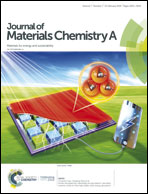1T-Molybdenum disulfide/reduced graphene oxide hybrid fibers as high strength fibrous electrodes for wearable energy storage†
Abstract
1T-Molybdenum disulfide (MoS2) modified reduced graphene oxide (rGO) hybrid fibers with good strength and energy storage performance were fabricated through a wet-spinning method. They can be widely used in wearable energy storage devices/textiles as fibrous electrode materials. In the hybrid fibers, graphene oxide nanosheets (NSs) are modified with ultrathin and large area MoS2 NSs to enhance the exposed active sites and pseudocapacitive activity. The pseudocapacitive, all-solid-state hybrid fiber shaped supercapacitor (ASFS) provides high strength (109.44–204.27 MPa) and high specific capacitances (134.38 F g−1, 332.85 mF cm−2 and 221.9 F cm−3 at a current of 50 mA). The capacitance of the hybrid supercapacitor is maintained at 100% of the initial capacitance when bent by 30 and 60 degrees. Then, 3 symmetrically assembled tandem and parallel ASFS groups in textile (ASFSs-T) were fabricated and show tunable voltage output, tailored capacitance, and outstanding flexibility. These high strength electrochemical electrode materials could be potential candidates for applications in practical and large-scale energy storage systems and clothing textiles.



 Please wait while we load your content...
Please wait while we load your content...